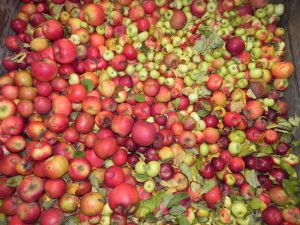In my early teens, my family moved to a large home surrounded by five acres of apple orchard outside Paris. Nestled inside a nine-foot brick wall, the property was surrounded by small farms that had fed the city of Paris for centuries. I was immersed in the rhythm of village life that had been going on for all those years.
Though a number of the apple trees were full-sized (around 30 feet), most were espaliered with the main cordons or arms about two feet off the ground with the fruiting spurs on shoots rising from them (similar to the way wine grapes are grown here in California).
Green grass was everywhere. My brother and I were tasked with mowing. We had no sooner finished mowing than it was time to begin again – nothing like the seasonal grasses so common to California.
My father, an avid vegetable gardener, hand dug our garden in the thick sod between the rows of apple trees. Some things, like radishes, green beans, peas and courgettes (zucchini to us), grew well. Things like tomatoes, not so much. I think the garden was a way my father kept in touch with his rural Kansas upbringing.
Outside the walls of our home were miles of French countryside interspersed with small villages. In France at that time farmers lived in the villages. Good growing land is far too valuable to waste on housing. In the connected row houses lining the village streets, a large two-door gate led to a courtyard where equipment and animals were kept. Early in the morning we would see farmers in their wagons pulled by a small tractor, or a two-wheeled tractor with a power take-off for all sorts of implements.
For my brother and I, bicycles were our main transportation. Cycling through the farms to the nearest village with a patisserie (bakery), we would buy three baguettes. One was always gone before we reached home. On our excursions through the countryside, we were able to follow the seasons on the farms we passed. Beginning in the early spring, rows of chenille—the French word for caterpillar—covered the fields in low tunnels. Under the grey, cloud-covered skies the crop protecting season extenders looked exactly like caterpillars. There were never huge fields of one crop, rather a few rows of broccoli or cabbage next to a couple of chenilles. No sooner was one crop harvested than another was planted with an economy of measure I can’t begin to imitate in my own garden.
To share this harvest, all we had to do was wait for the local Marche’ or market. On market day there would be forty or fifty stalls filled with produce with farm wives ready to bargain. From fresh seasonal vegetables to snails already cleaned in their own shells capped with farm fresh butter, it was all here. These market farms and bustling markets made the large grocery stores of America seem like a disconnect in our food sources. I guess this is why I am such a fan of our local farmers’ markets.
Jim Bliss is a University of California Cooperative Extension Master Gardener of Tuolumne County.

